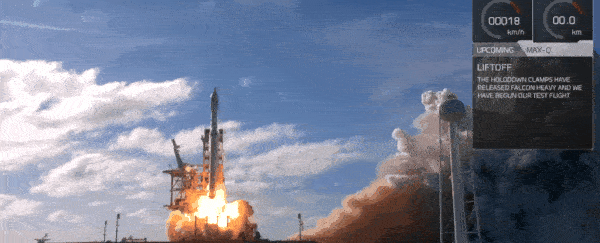SpaceX's Falcon Heavy rocket, currently the most powerful launch system on Earth, roared into the sky on Tuesday afternoon atop a pillar of smoke.
The rocket's three reusable boosters lifted the vehicle skyward, sending company founder Elon Musk's personal Tesla Roadster on a journey toward Mars orbit.
Musk was worried that the experimental 23-story rocket might explode with the force of 4 million pounds' worth of TNT. But Falcon Heavy did not meet that fate: It successfully cleared launch pad 39A at Kennedy Space Center.
Liftoff! pic.twitter.com/2ypESsi1sF
— SpaceX (@SpaceX) February 6, 2018
Musk has admitted his test payload is "silly," but Falcon Heavy's successful lift-off – a system that will cost about US$90 million per launch – could disrupt the industry.
"It means we're able to offer heavy-lift … for not much more than the cost of a Falcon 9," Musk told reporters on Monday, referring to SpaceX's $US62 million single-booster rocket. "If we're successful in this, it is game over for all other heavy-lift rockets."
The key to Falcon Heavy's low cost lies, like Falcon 9's, in the reusability of its 134-foot-tall boosters, each of which costs tens of millions of dollars to build.
The rocket's two side boosters landed successfully on the ground after launch.
Falcon Heavy side cores have landed at SpaceX’s Landing Zones 1 and 2. pic.twitter.com/oMBqizqnpI
— SpaceX (@SpaceX) February 6, 2018
SpaceX feed lost its video feed connection to the central core booster as it approached its landing spot in the ocean, but that's common and not necessarily an indicator of failure.
Other rocket boosters on the market today are discarded after launch.
Musk previously said Falcon Heavy's success would be akin to placing it in a market "where one aircraft company has reusable aircraft, and all the other aircraft companies had aircraft that were single-use … You sort of parachute out to your destination, and the plane would crash-land somewhere. Crazy as that sounds, that's how the rocket business works."
Musk's electric car has a spacesuit-clad dummy, called "Starman," in the driver's seat, plus a suite of video cameras.
"They should really provide some epic views if they work and everything goes well," Musk said.
However, the car's fate won't be known for about six hours: Falcon Heavy's uppermost stage, which carries Musk's tricked-out car, will coast for about six hours through intense radiation fields around Earth's magnetic Van Allen Belt.
"It's going to get whacked pretty hard" by high-energy particles, Musk said. "It's actually a radiation environment significantly worse than deep space. … Think of the Van Allen Belt as being essentially like a concentrating lens of charged particles."
If radiation doesn't zap the electronics of the upper-stage rocket, its engines will fire up, accelerate Musk's Roadster to about 24,600 miles per hours, and inject it into orbit that will loop indefinitely between Earth and Mars.
This risky six-hour manoeuvre is partly to prove SpaceX's rocket can survive the punishment, Musk said Monday – and hopefully win over new launch customers.
If the car is successfully launched on an orbit out to Mars, SpaceX will demonstrate that Falcon Heavy is capable of sending a spaceship and supplies out to the red planet.
Musk previously said that Tuesday's Falcon Heavy launch would be just the beginning of a flexible and powerful system that would closely match the power of NASA'shistoric Saturn V rocket.
"We could really dial it up to as much performance as anyone could ever want," he told reporters on Monday. "If we wanted to, we could actually add two more side boosters and make it Falcon Super Heavy, with … upwards of 9 million pounds of thrust."
With enough fuel and the right trajectory, the system has enough thrust to launch a payload heavier than a car to Pluto, let alone Mars.
"It could actually go further than they went with Apollo, possibly visit an asteroid or something like that," Musk said.
That would appeal to NASA, which is gearing up to launch several planet-, moon-, and asteroid-bound spacecraft in the coming years.
The space agency is also in an ever-present budget pinch – and behind schedule in building its own super-heavy-lift rocket, called Space Launch System.
This article was originally published by Business Insider.
More from Business Insider:
